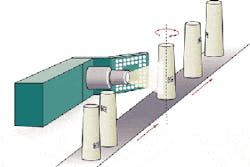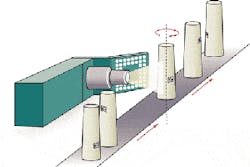Reader checks vials
Manufacturers of pharmaceutical glass vials often mark them with data-matrix codes to ensure that they can be traced along the manufacturing line. "One manufacturer of such vials faced a challenging task when it needed to automate the process of reading the data-matrix code," says Jean-Luc Laager, business development manager with AKAtech SA (Ecublens, Switzerland; www.akatech.ch).
Since the company needed to equip several production lines, it looked for a PC-free stand-alone reader. The vials, which contained a wide variety of pharmaceutical substances, were already marked with the data-matrix code. They were vertically conveyed to the reading station and then moved onto a labeling station. Before the vials were allowed to pass to the label applicator, the data-matrix code had to be read and the related data communicated to the label printer. The appropriate label would then be printed and applied to the vials.
"At the reading station," says Laager, "the data-matrix codes were difficult to locate and decode. At this station, the vials had a random angular position, making it impossible to accurately place the data matrix in the reader field of view." Additionally, the 1.5 × 1.5-mm square code combined with the curvature of the bottle made localization difficult.
As the conveyor transfers the vials along, each vial rotates every 50 ms, presenting a rotating barcode to the operator. To image this moving barcode, AKAtech deployed its AKAmatrix reader, a data-matrix reader that uses a 1024 × 1024 CMOS image sensor with a dynamic range of 120 dB, supplied by Fillfactory (Mechelen, Belgium; www.fillfactory.com.).
The AKAmatrix reader localizes and reads the code despite bottle curvature and strong reflections from the glass. Taking account of the mechanical construction of the conveyor, which spins the bottle around its vertical axis, the reader is operated in a linescan mode, possible thanks to the random pixel access capability of the CMOS sensor (see figure).
Instead of acquiring a complete sensor line of 1024 pixels, AKAmatrix is configured to scan a segment of 140 pixels. When synchronized with the speed of the conveyor belt, 600 scans of this line segment of 140 pixels are incrementally acquired across the sensor, resulting after one single rotation of the vial in a complete image of the vial lateral surface.
AKAmatrix software, running in the reader's internal processor, localizes and reads the code. The result is transmitted via an RS232 interface to the label printer. "Since there is only a single image captured," says Laager, "the quantity of data is minimized, allowing fast, optimized reading."

